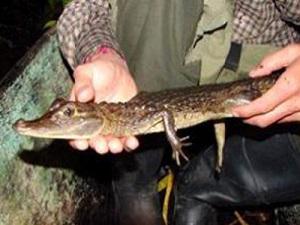Juan Fernando Duenas Serrano
This project intends to monitor the population status of the black caiman (C. niger) and the spectacled caiman (C. crocodilus) in three different localities at the Cuyabeno Wildlife Reserve, Sucumbius, Ecuador.

This project intends to monitor the population status of the black caiman (C. niger) and the spectacled caiman (C. crocodilus) in three different localities at the Cuyabeno Wildlife Reserve. In addition, the project seeks to compare the data gathered during this period, with data obtained in previous studies at the same localities. Finally, we want to make recommendations about the management that these species should have to assure their sustainability in their ecosystem.
These two caiman species are sympatric in the Reserve. The black caiman has suffered heavy hunting pressure in most of its original range, especially due to the high economic value of their skins. In the eastern lowland water systems of Ecuadorian Amazonia, the population of this species was depleted to critical levels at least until the 1970's (Asanza, 1992). The Ecuadorian populations were moved from CITES Appendix I to Appendix II, subjected to a zero annual quota for two years (Ross, 1998). This move was based on prior studies with important shortcomings: they failed to indicate the localities in which the collection of eggs and hatchlings of the species should be made, and the government capacity to monitor the wild populations was not described clearly (Ron, 1995). It has been suggested that the spectacled caiman invaded the habitat that the black caiman populations left when they where depleted (Medem, 1971; Ellis, 1980; Magnusson, 1982; Magnusson, 1985), nevertheless the extent of this suggestion in unclear as well as how the competition between both species would affect the recovery of C. niger (Herron, 1994). According to Ross (1998) the populations of this species are larger than the past and are doing well in most of its range due to their adaptability and resilience to hunting pressure (Herron, 1991). They constitute a potential economic resource for sustainable managing programs that could benefit people that live throughout the Reserve.
The study will use standardized methodologies applied and refined in previous studies (Ron, 1995; Vallejo, 1995). I will conduct night surveys at least along three different black-water lakes that are located within the reserve using a dug-out canoe. Identification of species, as well as estimates of the total size of the animals will be made based on the size of the heads as the literature describes (Herron, 1994). Whenever possible, the animals will be captured, marked, sexed and measured. Measures will be head length, total length (Tip of snout to tip of tail) and Snout-Vent length (Tip of snout to anterior edge of vent) as described in Herron (1991). This will allow the generation of a demographic structure of the populations based on size class partitioning of each caiman sighted. Genetic material will be collected cutting caudal and dorsal scales when marking process takes place. This material will be used in posterior population genetic studies and will be stored at Catholic University Zoology Museum (QCAZ). Night surveys will allow estimates of the relative densities of caimans encountered, wile mark-recapture data will permit estimation of the total size and structure of the populations (using specialized software, MARK 4.1). Behavioural parameters such as wariness, will be measured as the estimation of the distance the animal takes evasive actions wile the canoe approaches. This parameter shows how human influence affects behaviour of different populations of caimans (Ron et al. 1998). Finally, a-biotic variables as temperature of water, lunar phase and weather conditions will be recorded in each survey to account for their influence during the night-surveys. A map indicating the locations of each caiman surveyed, will be generated using GPS points.